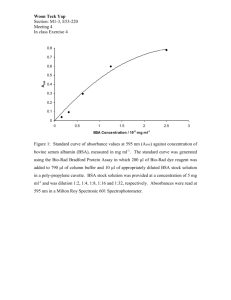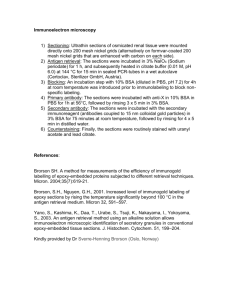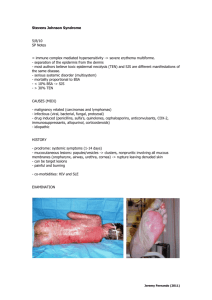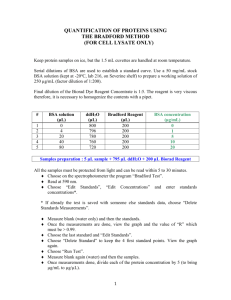Revista CENIC Ciencias Químicas. 41, No. Especial, 2010 Bovine
advertisement
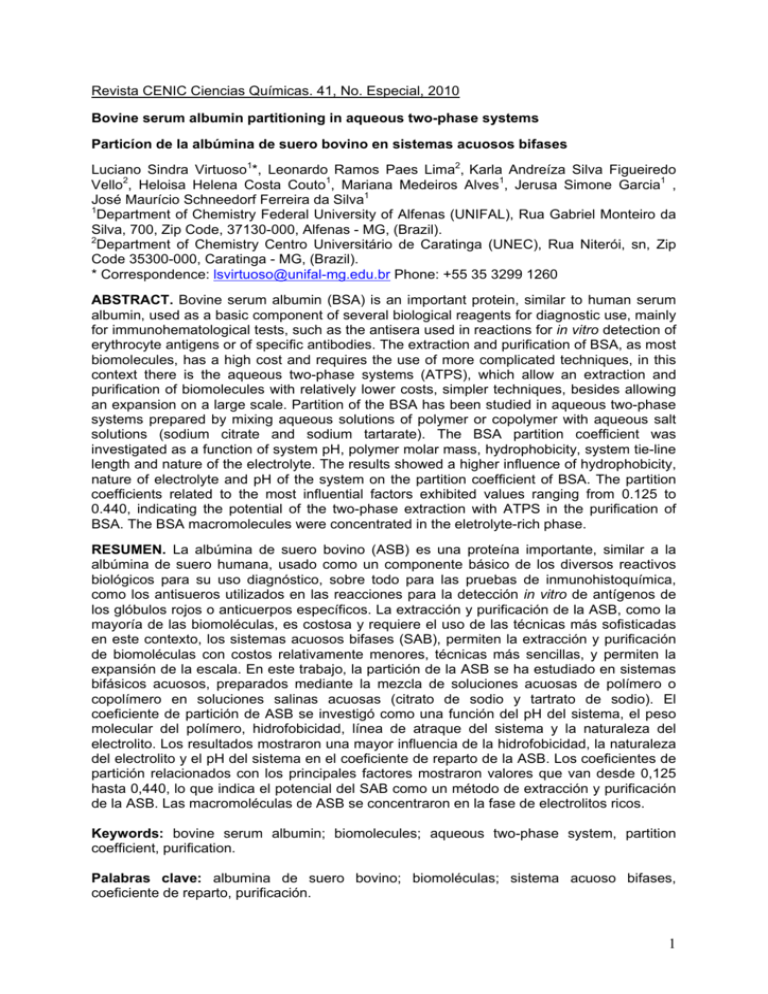
Revista CENIC Ciencias Químicas. 41, No. Especial, 2010 Bovine serum albumin partitioning in aqueous two-phase systems Particíon de la albúmina de suero bovino en sistemas acuosos bifases Luciano Sindra Virtuoso1*, Leonardo Ramos Paes Lima2, Karla Andreíza Silva Figueiredo Vello2, Heloisa Helena Costa Couto1, Mariana Medeiros Alves1, Jerusa Simone Garcia1 , José Maurício Schneedorf Ferreira da Silva1 1 Department of Chemistry Federal University of Alfenas (UNIFAL), Rua Gabriel Monteiro da Silva, 700, Zip Code, 37130-000, Alfenas - MG, (Brazil). 2 Department of Chemistry Centro Universitário de Caratinga (UNEC), Rua Niterói, sn, Zip Code 35300-000, Caratinga - MG, (Brazil). * Correspondence: lsvirtuoso@unifal-mg.edu.br Phone: +55 35 3299 1260 ABSTRACT. Bovine serum albumin (BSA) is an important protein, similar to human serum albumin, used as a basic component of several biological reagents for diagnostic use, mainly for immunohematological tests, such as the antisera used in reactions for in vitro detection of erythrocyte antigens or of specific antibodies. The extraction and purification of BSA, as most biomolecules, has a high cost and requires the use of more complicated techniques, in this context there is the aqueous two-phase systems (ATPS), which allow an extraction and purification of biomolecules with relatively lower costs, simpler techniques, besides allowing an expansion on a large scale. Partition of the BSA has been studied in aqueous two-phase systems prepared by mixing aqueous solutions of polymer or copolymer with aqueous salt solutions (sodium citrate and sodium tartarate). The BSA partition coefficient was investigated as a function of system pH, polymer molar mass, hydrophobicity, system tie-line length and nature of the electrolyte. The results showed a higher influence of hydrophobicity, nature of electrolyte and pH of the system on the partition coefficient of BSA. The partition coefficients related to the most influential factors exhibited values ranging from 0.125 to 0.440, indicating the potential of the two-phase extraction with ATPS in the purification of BSA. The BSA macromolecules were concentrated in the eletrolyte-rich phase. RESUMEN. La albúmina de suero bovino (ASB) es una proteína importante, similar a la albúmina de suero humana, usado como un componente básico de los diversos reactivos biológicos para su uso diagnóstico, sobre todo para las pruebas de inmunohistoquímica, como los antisueros utilizados en las reacciones para la detección in vitro de antígenos de los glóbulos rojos o anticuerpos específicos. La extracción y purificación de la ASB, como la mayoría de las biomoléculas, es costosa y requiere el uso de las técnicas más sofisticadas en este contexto, los sistemas acuosos bifases (SAB), permiten la extracción y purificación de biomoléculas con costos relativamente menores, técnicas más sencillas, y permiten la expansión de la escala. En este trabajo, la partición de la ASB se ha estudiado en sistemas bifásicos acuosos, preparados mediante la mezcla de soluciones acuosas de polímero o copolímero en soluciones salinas acuosas (citrato de sodio y tartrato de sodio). El coeficiente de partición de ASB se investigó como una función del pH del sistema, el peso molecular del polímero, hidrofobicidad, línea de atraque del sistema y la naturaleza del electrolito. Los resultados mostraron una mayor influencia de la hidrofobicidad, la naturaleza del electrolito y el pH del sistema en el coeficiente de reparto de la ASB. Los coeficientes de partición relacionados con los principales factores mostraron valores que van desde 0,125 hasta 0,440, lo que indica el potencial del SAB como un método de extracción y purificación de la ASB. Las macromoléculas de ASB se concentraron en la fase de electrolitos ricos. Keywords: bovine serum albumin; biomolecules; aqueous two-phase system, partition coefficient, purification. Palabras clave: albumina de suero bovino; biomoléculas; sistema acuoso bifases, coeficiente de reparto, purificación. 1 INTRODUCTION There is a great interest on extraction e purification of biological materials, and recently the necessity of development of new techniques in this area increased circumstantially. The most used techniques are chromatographic systems, process of liquid-liquid extraction, electrophoresis, steam distillation among others.1 These techniques have, in common, a high cost, complexity in the execution, beside the solvent and toxic materials utilization. From these necessities, researches have been developed, in the way to find an efficient process with a lower cost, that decrease the aggression to the environmental and allowing an expansion on a large scale. In this context, arises the Aqueous Two-Phase Systems (ATPS), which are a process of liquid-liquid extraction for separation and purification of biological materials like cells fragments, amino acid, peptides, nucleic acids and protein molecules.2 ATPS can be composed by water and two different polymers, or water, polymer and electrolyte. So, ATPS are an attractive alternative procedure for the separation and purification of proteins on a large scale. The first work with ATPS was reported by Beyjerink in 1896, that observed that two aqueous solution of starch and agar, when mixed, there was the formation of a biphasic system.3 In 50th decade, Albertsson 2 proposed an application for this systems in the extraction and purification of bioparticles. After that, others researchers studied this systems with this same purpose, and the most studied system and the most applied at present is formed by polyethylene glycol + dextran + water.1 ATPS are, generally, composed by water solution of two structurally distinct hydrophilic polymers or of one polymer and electrolytes, like some salts or bases. One of the phases is enriched in one type of polymer and the other is enriched in a different polymer or electrolyte, but in both, the most component is water, 60 to 90%,4 and this fact make this systems an efficient alternative for extraction of proteins, because it has a pleasant middle for biomolecules, avoiding their denaturation and inactivation. The systems formed by polymer and salts are most used for large-scale extraction. The migration of the proteins for one phase to other is, partly, result of salting out effect of one of the phases about this protein 5 and is represented by the partition coefficient (Kp). The value of this coefficient is obtained according to the equation 1: where [P]FS corresponds to the concentration of the protein in top phase and [P]FI the concentration of the protein in bottom phase. The partition of the protein can be influenced by parameters of the system, such as nature of the salt, molar weight of polymer, concentration of the components, hydrophobicity, temperature and pH 6 and by parameters of the biomolecules, like size, structural conformation (secondary structures, tertiary and quaternary) and composition (primary structure), hydrophobicity and electric charge.4 The partition of Bovine Serum Albumin (BSA) has been done in ATPS formed by two different polymers 7, 8, 9 and in this work a partition of BSA was done in ATPS composed be water, polymer and salt. Albumin is the most abundant protein in plasma, representing 40 to 60% of total proteins.10 Their principal biological functions are related to transport and storage of a great number of endogenous or exogenous substances, to maintenance of colloid osmotic pressure of plasma and to storage of endogenous amino acids. BSA is a protein with structure and physicochemical properties very similar to human albumin, it has a only polypeptide chain, with 580 amino acids, and a molecular weigh of, approximately, 66 kDa. Its secondary structure has many serine residues, which are helical, in most part of the chain, and under no physiological conditions undergoes significant changes on its conformation.11 BSA occupies a prominent place like reagent in many diagnostics tests, mainly in the immunohematological tests, influencing hemagglutination in determinations, such as, blood type and Rh factor.12 BSA can be used for enrich culture media of a variety of microorganisms and tissue cells. 2 MATERIALS AND METHODS Poly(ethylene oxide), PEO, of molar mass of 1500, 2000, 4000 g mol−1, was obtained from Sigma (St. Louis, MO, USA). The triblock copolymer L35 was purchased from Aldrich (St. Louis, MO, USA) with an average molar mass of 1900 g mol−1. This copolymer has the following nominal composition: (EO)11(PO)16(EO)11. All macromolecular compounds were used as received. The inorganic compounds sodium citrate (99%), sodium tartarate (99%) and NaOH (98%) were purchased from Synth (Diadema, São Paulo), Riedel-de Haen (Hanover, Germany) and Vetec (Rio de Janeiro, Brazil), respectively. Bovine serum albumin (BSA) (96–99%) and Coomassie Blue G250 was purchased from Sinopharm Chemical Reagent Co., Ltd. (Shanghai, China). All salts were of analytical grade and used without any further purification. Distilled water was used in all experiments. Aqueous two-phase systems (PEO 1500, 2000 or 4000/sodium citrate/water, L35/sodium citrate or sodium tartarate/water) were prepared in five different compositions and were allowed to equilibrate at 25.0oC according to the phase diagrams described in the literature.13,14,15 Aliquots of the top and bottom phase were removed and a total of 3.0 g of each phase were mixed with 30 μL of the BSA solution 9,4%(m/m) in two glass tubes. These tubes were stirred for about 2 min, centrifuged at 2880 g for 15 min and subsequently transferred to a thermostatic bath (TECNAL, BR) at 25.0 oC, where the systems stayed for approximately 24 hs, to obtain the thermodynamic equilibrium. Each resulting phase was carefully collected with a syringe, leaving a 5 mm thick layer below and above the interface. The content of BSA on each phase was quantified by Bradford’s method, using a spectrophotometer UV/Vis 2550 (SHIMADZU). The partition coefficient (KBSA) of the BSA molecules between the two phases were determined. A study of the influence of pH on partition coefficient was done using pH’s values of 3.5, 4.0, 7.0 and 8.0 in a tie line length 48.18% of ATPS composed of L35 1900 + sodium citrate + water. This value of system’s pH was adjusted by adding aliquots of sodium hydroxide. The partition study of BSA was done in duplicate, and its quantification in both phases were determined by measuring the absorption at 595 nm according to the method of Bradford. RESULTS AND DISCUSSION All phase diagrams were previously constructed and are reported elsewhere.13–15 After mixing the components at a specific global composition, the systems spontaneously separated into two isotropic transparent phases, with the top and bottom phase being enriched in macromolecules and salt, respectively. Tie-line length (TLL) is an important thermodynamic parameter that expresses the difference between the intensive thermodynamic properties of the ATPS two phases. It is commonly used as a variable that determines the processes of solute partition. The difference between the intensive thermodynamic properties is enhanced with the increase in the value of TLL. TLL is calculated according to Eq. 2: where CP and CS are the polymer and salt concentrations in % (w/w), and “t” and “b” indicate the top and bottom phase, respectively. Generally, the uneven solute distribution will increase with increasing TLL values. In this work, the partition coefficient of BSA macromolecules was determined for five different TLL for all ATPS. Efect of PEO Molar Mass on the Partitioning Behavior In general, if the molar mass of the ATPS polymer is increased, the concentration of solute decreases in the phase where that polymer predominates. This occurs due to increase in macromolecular size reduces the contribution of configuractional entropy to minimize the solute Gibbs transfer energy, affecting the partitioning behavior of any solute. Figure 1 shows the influence of PEO molar mass on the partition coefficient value as a function of the tie-line length for systems formed by PEO1500 or PEO 2000 or PEO 4000/sodium citrate/water. As can be observed, in the ATPS formed for PEO1500 and PEO 2000 there is no significant 3 effect of the macromolecular size on the BSA, however, for the ATPS formed by PEG 4000 a greater displacement of BSA to polymer phase was observed in the partitioning behavior. When the partitioning behavior of a solute is mainly determined by enthalpic intermolecular interactions, the increase in the polymer molar mass does not affect the significantly KBSA values. In view of this, the transfer of BSA in systems consisting of PEO and sodium citrate is not only enthalpically driven. Fig. 1. Effect of PEG molecular weight on the Bovine Serum Albumin partition coefficient (KBSA) as a function of the tie-line length (TLL) values in PEG/sodium citrate ATPS at 25.0oC in pH =7. (■) PEO 1500, (•) PEO 2000 and (▲) PEO 4000. Influence of the Salt Type on the Partition Coefficient of BSA From the results presented in Fig. 2, the influence exerted by the electrolyte formed from the ATPS on bovine serum albumin partitioning could be observed. Salt type in the ATPS was observed to have a significant effect on the partition coefficient of the protein. For the systems studies, the partition coefficient obtained for the system formed by sodium citrate was greater than that formed by tartrate salt indicating that the change of anion significantly alters the magnitude of the intermolecular interactions in ATPS's, therefore interfering on the partition coefficient for BSA. When a protein is partitioned in a system containing PEG and salt, the type and concentration of the salt has an effect on the hydrophobic interactions between the protein and the system medium; the salt ions interact with protein surface charges to form a double electric layer. Therefore the protein is dehydrated due to the hydration effect of the salt ions surrounding the protein and the protein hydrophobic zones are gradually exposed, increasing with augments in salt concentration. The influence of salt ions on protein behavior is usually characterized by the position of each ion in the Holfmeister series. At elevated concentrations, ions to the left of the series diminish the solubility of the protein, increasing the hydrophobic interactions and the hydration effect of salt molecules surrounding the proteins causing greater dehydration. There is then an increase in protein–PEG interactions, augmenting extraction to the PEG rich phase. 4 Fig. 2. Influence of the nature of the ATPS electrolyte, on the Bovine Serum Albumin partition coefficient (KBSA) as a function of the tie-line length (TLL) values at 25.0oC in pH =7.0. ATPS: (•) L35 1900 + sodium citrate + water and (■) L35 1900 sodium tartarate + water. Hydrophobic Effect on the Partition of BSA Fig. 3. Hydrophobic effect on the BSA partition coefficient (Kp,BSA) as a function of the tie-line length (TLL) values at 25.0oC in pH=7. ATPS: (■) PEO 2000 +sodium citrate + water and (•) L35 1900+sodium citrate +water. Figure 3 shows the partition coefficient of BSA versus TLL in systems formed by PEO 2000 + sodium citrate + water and L35 1900 + sodium citrate + water. As can be seen, the partition coefficient decreases when the hydrophobicity of the top phase increases. The difference in hydrophobicity between the copolymer-rich phase and the PEO-rich phase in these ATPS is due to the existence of propylene oxide segments in L35 macromolecules, which is composed of 50% in weight of poly(propylene oxide) (PPO) units. The PPO 5 segments exhibit weak molecular interaction with water molecules. The L35 macromolecules feature the ability to form spherical micelles by self-assembly. The hydrophobic nature of the PPO group induces aggregation of the macromolecules into nanostructures with core sizes of approximately 5–10 nm, consisting of only the PPO block, and a corona region consisting of water and PEO blocks. The decrease in the BSA partition coefficient values in systems formed by L35 copolymer indicates that the BSA has no tendency to solubilize in the hydrophobic core of the micelles. Effect of the System PH on BSA Partitioning Fig. 4. Effect of pH of the system on the Bovine Serum Albumin partition coefficient (KBSA) in the ATPS L35 1900 + sodium citrate + water; the tie-line length (TLL) is equal to 48.18 % (w/w). The effect of pH on the BSA partition behavior in ATPS formed by L35 1900 + sodium citrate + water is demonstrated in Fig. 4. The results reveal a remarkable pH effect considering the difference in the values of partition coefficients obtained at pH below and above the isoelectric point (PI) of BSA. The change in partition coefficient can be explained by considering the charge of the protein surface compared to its pI. The protein carries net negative charge when the pH of the system is higher than the pI of the protein. While the pH of the system is below its pI, the result will be reversed. The negatively charged proteins tended to be distributed to the upper phase and the positively charged proteins to the bottom phase in the PEG-salt systems. As BSA became more negative (pI = 4.8) by increasing pH (7.0–8.0) of the system, an increase of the partition coefficient was observed compared to experiments performed at pH 3.5 and 4.0. With the objective of better understanding the partitioning behavior of bovine serum albumin in the ATPS, the Johansson’s model16 based on the Flory–Huggins theory was applied. This model consists of simple analytical equations that express the partition coefficient in terms of enthalpic and entropic contributions. Entropy variations associated with the bovine serum albumin transfer process are determined by the equation 2. where KBSA represents the bovine serum albumin partitioning coefficient, MMBSA is the molar mass of the protein, ρ is the numeric global molecular density of the ATPS, nt is the total 6 number of molecules in the upper phase, nb is the total number of molecules in the lower phase and Vt and Vb are the volumes of the upper and lower phases, respectively. Disregarding enthalpic contributions for solute partitioning, the physical interpretation of the equation indicates that with respect to the entropic contribution for BSA transfer between the phases, values of coefficients partition different from 1 occur only if the number of molecules per unit volume in the two phases is different. The referred equation shows that the solute will partition to the phase where the molecular density is greatest. In the majority of ATPS currently known, water molecules make up the majority of both phases and therefore water is the determining component for the numeric density of the different phases. Generally, entropy contributions will cause the protein to partition to the phase with the greatest concentration of water molecules. During protein partitioning in aqueous two-phase systems composed of a polymer/electrolyte mixture, entropic drive forces act to concentrate the biopolymer in the salt rich phase due to its greater numeric density.17 The enthalpy contribution for partitioning of the solute is given by Eq. 3: and are the volumetric fraction of the component “i” in the top and bottom where is the potential effective pair between the ATPS components phase, respectively; formed by “i” with the solute “s”, and is the potential effective pair between the components “i” and “j” in the top or bottom phase the ATPS. Protein concentration in the polymer rich phase only occurs in these ATPS (salt/polymer) when enthalpic interactions contribute to partitioning behavior, for example, where there are specific interactions between the protein and polymer. Equation 3 expresses all enthalpic interactions which occur throughout the protein transfer process. The enthalpy contribution for protein partitioning can be separated in two terms. The first refers to the energy difference due to all types of interactions which occur between BSA and the components present in both the upper and lower phases. This term reflects the tendency of the protein to transfer itself to the phase where there is a superior concentration of the component with which the protein has greatest interaction. The second term in equation 3 represents the differences in enthalpy content between the phases, being that energy only originates from the different interactions between the ATPS components. This term does not express the interactions between the proteins and the other compounds. The dependence of partition coefficients in relation to the difference between the total enthalpy energy in the upper and lower phases emerges because BSA transfer between phases involves the destruction and formation of new interactions. BSA assembly in the upper phase implies disruption of interactions between PEG and water causing the formation of a cavity in which the partitioned proteins can gather. Additionally, the departure of proteins from the lower phase allows for the formation of new interactions between salt and water components which are dominant in the lower phase. Analysis of the second term of the equation shows that BSA will partition to the phase with greater enthalpic energy and the system will therefore utilize less energy for cavity formation. In the ATPS studied, the PEG rich phase possesses greater energy content, because in the salt rich bottom phase, ion–dipole and ion–ion interactions greatly reduce its energy. Therefore, partitioning of biosolutes is governed by the sum of the natural entropic and enthalpic contributions to the system. When one of these contributions, entropic or enthalpic, overshadows the other, it will govern the partitioning mechanism. 7 CONCLUSIONS Aqueous two-phase systems have proven to be a powerful, attractive alternative to BSA purification. Protein partitioning in aqueous systems can be influence by various factors. In this work, the BSA partition coefficient was investigated as a function of system pH, polymer molar mass, hydrophobicity, system tie-line length and nature of the electrolyte with the objective of improving the selectivity of the ATPS and determining the best conditions for separation. The results showed a higher influence of hydrophobicity, nature of electrolyte and pH of the system on the partition coefficient of BSA. The partition coefficients related to the most influential factors exhibited values ranging from 0.125 to 0.440, indicating the potential of the two-phase extraction with ATPS in the purification of BSA. The BSA macromolecules were concentrated in the eletrolyte-rich phase. The main driving power of these transfers is enthalpy exchange during the transfer process, attributed to a specific interaction between the BSA and bottom phase components. The departure of proteins from the lower phase allows for the formation of new interactions between salt and water components which are dominant in the lower phase because in the salt rich bottom phase, ion–dipole and ion–ion interactions greatly reduce its energy stabilizer BSA in this phase. ACKNOWLEDGMENT The authors wish to knowledge the National Counsel of Technological and Scientific Development (CNPq) and the Foundation to Research Support of the Minas Gerais State (FAPEMIG) for the financial support. REFERENCES 1. Reis IF, Reis JB, Barbieri RS. Tópicos em ciências naturais e da saúde. Caratinga, Centro Universitário de Caratinga: 2010. 2. Albertsson PA. Partition of cell particles and macromolecules. 3a ed. New York, Wiley: 1986. 3. Beijernick MW. Original mitteilung uber eine eigentumlichkeit der loslichen starke. Centrabl. Bakteriologie, Parasitenkunde Infektioskrankheiten. 1896;22:699-701. 4. Silva L H M, Loh W. Sistemas aquosos bifásicos: fundamentos e aplicações para partição/purificação de proteínas. Quim Nova. 2006; 29 (6): 1345-1351. 5. Pereira M, Wu Y, Madeira P, et al. Liquid-liquid equilibrium phase diagrams of new aqueous two-phase systems: Ucon 50-HB5100 + ammonium sulfate + water, Ucon 50-HB5100 + poly(vinyl alcohol) + water, Ucon 50-HB5100 + hydroxypropyl starch + water, and poly(ethylene glycol) 8000 + poly(vinyl alcohol) + water. J Chem Eng Data. 2004;49:43-7. 6. Bezerra RP, Borba FK, Moreira KA, et al. Extraction of amylase from fermentation broth in poly (ethylene glycol) salt aqueous two-phase system. Braz Arch Biol Technol. 2006;49(4):547-55. 7. Sarubbo LA, Oliveira LA, Porto AL, et al. Partition of proteins in aqueous two-phase systems based on cashew-nut tree gum and poly(ethylene glycol). Braz Arch Biol Technol. 2004;47(5):685-91. 8. Alves JG, Chumpitaz LD, Silva LH, et al. Partitioning of whey proteins, bovine serum albumin and porcine insulin in aqueous two-phase systems. J Chromatogr B. 2000; 743:235-9. 9. Gunduz U, Korkmaz K. Bovine serum albumin partitioning in an aqueous two-phase system: Effect of pH and sodium chloride concentration. J Chromatogr B. 2000;743:255-8. 10. Burtis CA, Ashwood ER. Tietz fundamentos de química clínica. 4a ed. Rio de Janeiro: Guanabara Koogan:1998. 11. Nakamura K, Era S, Ozaki Y, et al. Conformational changes in seventeen cystine disulfide bridges of bovine serum albumin proved by Raman spectroscopy. Fed Eur Biochem Soc Lett. 1997;417:375-8. 8 12. Tanaka K, Sawatani E, Shigueoka EM, et al. Isolation of bovine plasma albumin by liquid chromatography and its polymerization for use in immunohematology. Braz J Med Biol Res. 2001;34 (8):977-83. 13. Oliveira RM, Coimbra JSR, Minim LA, et al. Liquid–liquid equilibria of biphasic systems composed of sodium citrate + polyethylene(glycol) 1500 or 4000 at different temperatures. J Chem Eng Data. 2008;53:895-9. 14. Martins JP, Mageste AB, da Silva MC, et al. Liquid-liquid equilibria of an aqueous two-phase system formed by a triblock copolymer and sodium salts at different temperatures. J Chem Eng Data. 2009;54:2891-4. 15. Murugesan T, Perumalsamy M. Liquid-liquid equilibria of poly(ethylene glycol) 2000 + sodium citrate + water at (25, 30, 35, 40, and 45)°C. J Chem Eng Data. 2005;50: 1392-5. 16. Johansson HO, Karlström G, Tjerneld F. et al. Driving forces for phase separation and partitioning in aqueous two-phase systems. J Chromatogr B. 1998;3:711. 17. Imelio N, Marini A, Spelzini D, et al. Pepsin extraction from bovine stomach using aqueous two-phase systems: molecular mechanism and influence of homogenate mass and phase volume ratio. J Chromatogr B. 2008;73:133-8. 9


